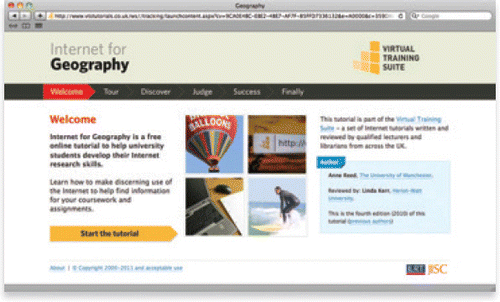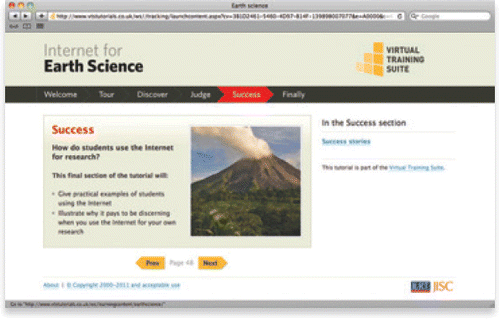Abstract
The Virtual Training Suite provides free online tutorials on many higher education subjects, which can help students with academic Internet skills. The Earth Science and Geography tutorials were recently updated by a national team of academics, teaching staff and librarians in UK universities and colleges, with an increased focus on research skills and the importance of peer reviewed resources. CitationThe Virtual Training Suite (2011) is a JISC-funded national Internet service based at the Institute for Learning and Research Technology (ILRT) at the University of Bristol.
In August 2010, the Virtual Training Suite service launched new editions of 30 free tutorials, including Internet for Earth Science and Internet for Geography, which teach Internet research skills for subjects covered by GEES. These are ideal for students looking for advice and guidance on using the Web for their studies, especially those who:
struggle to find the right information for university work
get marked down for citing inappropriate sources in their assignments
rely too heavily on Google, Wikipedia and the open web, because they are unaware of key academic and library sources.
Since the last editions of these tutorials appeared, feedback has indicated a growing recognition of the need to help students develop Internet research skills. It also suggested that helping students to understand peer-review was more important than ever in a Web 2.0 world of user generated content.
How do the tutorials work?
Each tutorial takes around one hour to complete, and is designed to appeal to a range of students, using practical exercises, quick quizzes and worked examples, as well as text optimised for online reading. Students can work through parts of a tutorial, and return to it later. Student learning can be reinforced, by using the Links Basket to collect a list of useful websites to refer to later (a bit like the Amazon shopping basket).
Each tutorial follows a similar template, having four sections:
Tour — focuses on the academic information landscape on the Internet and aims to create a mental map for students of the key scholarly sources for geography and earth science.
Discover — offers updated guidance on how to find scholarly information online; choosing the right search tool and looks at the importance of developing a search strategy.
Judge — discusses how critical thinking can improve the quality of online research and provides guidance on how to judge which Internet resources are appropriate for university work.
Success — provides practical examples of students using the Internet for research — successfully and unsuccessfully, so that students can learn from the mistakes of others, as well as by example.
How can the tutorials be used?
The tutorials can be used as a piece of self-directed learning for students, as the formal structure for an in-class assessment of online information, or as a handbook to guide students through the use of the Internet for their coursework.
Feedback from university staff suggests that they find it useful to point students to the tutorials from course handbooks, Virtual Learning Environment support sites and course web pages. We are always interested to hear how lecturers and students use the Virtual Training Suite — do please email us with your feedback.
References
- The Virtual Training Suite 2011 http://www.vts.intute.ac.uk/
- Twitter Follow the Virtual Training Suite at http://twitter.com/#!/VTStutorial

